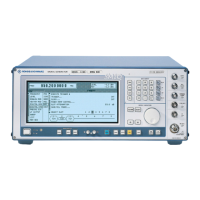SMIQ Digital Modulation
1125.5555.03 E-92.99
2.10.6 Envelope Control
For TDMA radio networks, in addition to digital modulation, a time-synchronous control of the envelope
of the RF output signal is required. To this effect, SMIQ is equipped with an analog envelope modulator
which can be driven via connector POWER RAMP. Instead of the analog control signal the digital
signals BURST GATE and LEV ATT can be used to control the envelope modulator. In the modulation
coder, a ramp with settable slope is obtained from data changes from high→low or low→high of the
digital BURST GATE signal. The resulting analog signal is taken to the envelope modulator and is
provided at connector POWER RAMP. The LEV ATT signal serves for a defined level reduction.
x dB
Level attenuation
RF
Π
RF OUT
Envelope control
BURST GATE
LEV ATT
POWER RAMP
Fig. 2-59 Envelope control in SMIQ with modulation coder
The digital envelope control signals can be fed in externally via connector PAR DATA. With option Data
Generator SMIQB11 provided, the signals can also be generated internally by programming them in the
CONTROL LIST (see Section "Modulation Data from Lists").
The following table shows the logic function of the two signals BURST GATE and LEV ATT.
Table 2-12 Logic function of signals BURST GATE and LEVEL ATT
BURST GATE LEV ATT Remark
1 0 Full level
1 1 Level reduced by the value set in dB under POWER RAMP CONTROL -
ATTENUATION
0 X Maximum level reduction

